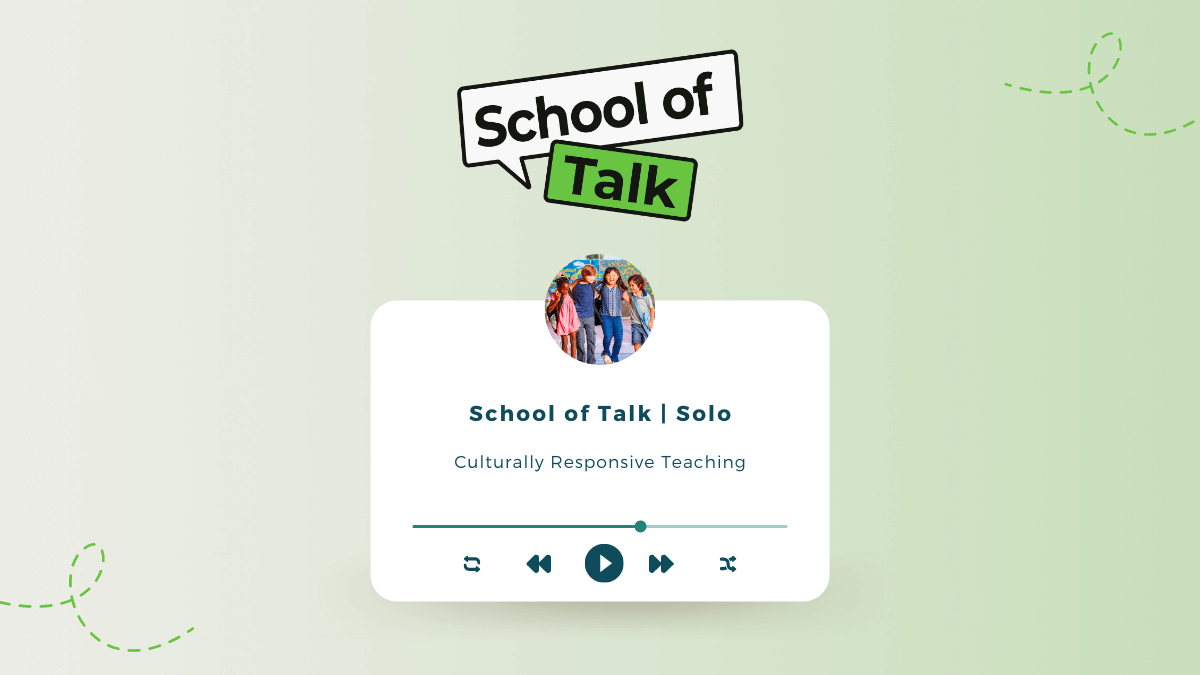In This Episode of School of Talk
This episode is all about culturally responsive teaching.
If you’re passionate about making your school and classroom a welcoming place for all students, you’ll want to listen to this one.
We’re breaking down what culturally responsive teaching is and how you can practice it in your classroom.
Episode Highlights:
What is culturally responsive teaching?
First, let’s identify what culturally responsive teaching is. Dr. Gloria Ladson-Billings (1994) describes culturally responsive teaching as “a pedagogy that empowers students intellectually, socially, emotionally, and politically by using cultural referents to impart knowledge, skills, and attitudes.”
Culturally responsive teaching is all about meeting the diverse needs of students in your school, whose economic and cultural backgrounds vary, along with their learning styles and learning needs. Culturally responsive teaching or cultural intelligence in education helps to create a learning environment that is engaging and accessible to a broader range of students.
How can you be a culturally responsive teacher?
Self-reflection and assessment:
As human beings, we all have implicit biases that impact the way we interact with the world around us.
The way that we unconsciously understand, act and make decisions are all impacted by our implicit biases. As teachers, we must become aware of our implicit biases through self-reflection and questioning our responses.
As we slow our thinking, ask questions, and combat stereotypes, we are working towards becoming more culturally responsive.
Building strong relationships:
Of course, relationship building is at the foundation of any nurturing learning environment, and creating a culturally responsive classroom means creating an environment in which students of all cultures feel comfortable and ready to learn.
Allowing your students to feel represented in the classroom through personal discussion and sharing, as well as celebrating both diversity and commonalities in the classroom can also go a long way to telling students that they belong.
Building a safe space for students goes hand in hand with creating a space where students can comfortably ask questions and challenge the status quo.
When having discussions about a current event or behavior, be sure to keep the conversation focused on learning, not criticizing.
Encouraging critical thinking in a safe, judgment-free zone will help your students feel empowered as they further their understanding of one another and the world around them.
Teach for all cultures
Does your classroom or workspace visually represent diverse cultures?
Incorporating posters, books, games, and other learning materials that showcase a variety of skin colors, hairstyles, family units, and physical characteristics can help to ensure all of your students feel equally represented in the room.
Aside from the physical environment, your lessons and activities need to reflect all learners in your room.
Books are another great way for educators to learn and share their learning with their students.
As educators, we aren’t expected to have all of the answers but we can lean on resources that help us and our students relate to each other.
Ultimately, by assessing your teaching practices and modifying your instruction to consider all students’ backgrounds and readiness levels you can allow your students to feel more engaged and represented at school.
Cultural competence is a continually-evolving practice and it starts with teachers who want to make their classroom a welcoming place for all students.
In our mission to create a world where every student experiences the power of a great teacher, it’s never been more important to listen, educate ourselves, and push our comfort levels to ensure all of our students feel represented.
If you’d like to read more about culturally responsive teaching practices, you can click here:
- Why culturally responsive teaching matters now more than ever
- 5 steps to becoming a culturally responsive teacher
- Assessing your cultural competence: A checklist for culturally responsive teachers
THANK YOU TO OUR SCHOOL OF TALK SPONSOR



